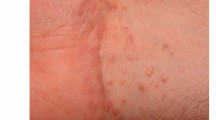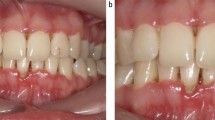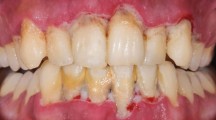Key Points
-
Actinomycosis is a supparative and often chronic bacterial infection most commonly caused by Actinomyces israelii.
-
Actinomycotic infections may mimic more common oral disease or present in similar way to malignant disease.
-
Treatment of actinomycosis involves surgical removal of the infected tissue and appropriate antibiotic therapy to eliminate the infection.
Abstract
Actinomycosis is a suppurative and often chronic bacterial infection most commonly caused by Actinomyces israelii. It is rare in dental practice. In the case reported the patient presented to his general dental practitioner complaining of a loose upper denture. This was found to be due to an actinomycotic infection which had caused extensive destruction and sequestration of the maxillary and nasal bones and subsequent deviation of the nasal septum.
Similar content being viewed by others
Introduction
Actinomycosis is a suppurative and often chronic bacterial infection most commonly caused by Actinomyces israelii. Several species have been isolated from the oral cavity of humans, including A. israelii, A. viscosus, A. naeslundii and A. odontolyticus.1 As suggested by Cope in 1938 the infection may be classified anatomically as cervicofacial, thoracic or abdominal. The most common is cervicofacial, which accounts for over half of reported cases.2
Actinomycosis in the maxilla accounts for only 0.5-9% of all head and neck cases.3 There are only a few cases reported in the literature of primary actinomycosis arising within the maxilla. Although rarely seen in day to day dental practice actinomycosis of the oral cavity is a highly significant condition due to its aggressive and locally destructive nature. We report a case of actinomycosis leading to extensive destruction and sequestration of the maxillary and nasal bones and deviation of the nasal septum, resulting in a saddle deformity of the nose, affecting a patient who initially presented to his general dental practitioner complaining of a loose upper denture.
Case report
An 85-year-old Caucasian male was referred to the oral and maxillofacial department by his general dental practitioner (GDP) complaining of a loose upper denture and extrusion of 'sharp fragments' bilaterally from his upper premolar regions. He also gave a recent history of recurrent nasal discharge, for which he was under the care of an ear, nose and throat department. His general health was unremarkable apart from an allergy to penicillin.
On examination the patient was edentulous in the upper arch and had evidence of bony sequestra arising from the surface of his upper alveolus (Fig. 1). He was partially dentate in the lower arch with no evidence of other pathology.
The provisional diagnosis included either a malignant, infective or inflammatory process. The patient was subsequently investigated with plain radiographs and a CT scan of his mid-face (Fig. 2). The CT scan demonstrated extensive irregular demineralisation and patchy erosion of the nasal and maxillary bones with complete opacification of the right and to a lesser extent the left maxillary antra. The report of the CT indicated the appearances were highly suggestive of a diffuse malignant process although an extensive erosive or inflammatory process could not be excluded from the differential diagnosis.
In order to relieve his symptoms and reach a diagnosis, debridement of the infected area (including removal of the bony sequestra) was undertaken and the tissue was sent for histological examination. The histology report showed the debrided bone contained large numbers of organisms consistent with the features of actinomyces, with no evidence of malignancy. A diagnosis of actinomycosis of the maxillary and nasal bones was made. The patient was promptly treated with oral clindamycin due to his allergy to penicillin.
Following the initial debridement the patient continued on oral antibiotics for several months and made good progress. He underwent an antral washout and remained under the care of both the maxillofacial and ENT departments due to his recurrent nasal discharge and subsequent nasal fistula formation.
The improvement in the patient's symptoms was maintained but he required further debridement of his maxilla approximately a year after his initial presentation due to recurrence of bony sequestra. At his last review appointment he had had no symptoms for several months and the oral mucosa was healthy. He will continue to be reviewed in the maxillofacial department biannually until complete resolution of the infection was apparent.
Comment
In humans species of actinomyces are frequently part of the normal flora of the oropharynx, gastrointestinal tract, and female genital tract. They are of low pathogenicity and generally only cause infection in the presence of local predisposing factors such as a breach of the oral mucosa and/or systemic factors. Hence oral and cervicofacial actinomycosis is a rare complication of dental operations, oral and maxillofacial trauma and the sequelae of dental caries,6 as well as systemic conditions affecting the immune system such as diabetes and HIV infections.
Although actinomycotic infections of the cervicofacial region are uncommon, they are important in dental practice because they may mimic more common oral disease – primarily dentally related infection – but may also present in a similar way to malignant disease. Diagnosis can be difficult as it depends on the detection of sulphur granules in the exudate, the characteristic appearance of the organism on culture and in the tissues on histological examintion.1
Treatment of actinomycosis involves surgical removal of the infected tissue and appropriate antibiotic therapy to eliminate the infection. Penicillins, erythromycin, streptomycin, lincomycin, vancomycin, cephalosporins, chloramphenicol, clindamycin, and tetracyclines have all been used with success in actinomycosis.5 A prolonged course of several months treatment is necessary with periodic review of antibiotic sensitivities and response.1,5 Long term follow-up is also needed as infection can recur after a period of quiescence.7
Before the role of actinomycosis in the suppurative process became apparent in the case reported here a significant amount of bony and cartilaginous tissue had been lost as a result of the infection. As a consequence the nasal septum collapsed and deviated to the extent that the right nasal passage had become completely obstructed. This is illustrated in Figure 3.
Conclusion
This case illustrates the need to bear in mind the possibility of an actinomycotic infection being either the sole or partial cause of recurrent or persistent oral infections and the need for prompt and thorough investigation and treatment.
References
Topazian R G, Goldberg M H . Oral and maxillofacial infections, 2nd ed. pp 403–407. Philadelphia: WB Saunders, 1987.
Belmont M J, Behar P M, Wax M K . Atypical presentations of actinomycosis. Head Neck 1999; 21: 264–268.
Esson M, Lee J . Actinomycosis in the maxilla – a case report. Int J Oral Maxillofac Surg 2005; 34 suppl 1: 132.
The British Society for Antimicrobial Chemotherapy. http://www.bsac.org.uk/pyxis/Head_and_Neck_Infections/ Pharyngeal%20space%20infections/Cervicofacial%20actinomycosis/ Cervicofacial%20actinomycosisF.htm. Accessed June 2008.
Alamillos-Granados F J, Dean-Ferrer A, García-López A, López-Rubio F . Actinomycotic ulcer of the oral mucosa: an unusual presentation of oral Actinomycosis. Br J Oral Maxillofac Surg 2000; 38: 121–123.
Watkins K V, Richmond A S, Langstein I M . Nonhealing extraction site due to Actinomyces naeslundii in patient with AIDS. Oral Surg Oral Med Oral Pathol 1991; 71: 675–677.
Holly L, Bartell M D, Michael L, Sonabend M D, Sylvia Hsu M D . Actinomycosis presenting as a large facial mass. Dermatol Online J 2006; 12: 20.
Author information
Authors and Affiliations
Corresponding author
Additional information
Refereed paper
Rights and permissions
About this article
Cite this article
Crossman, T., Herold, J. Actinomycosis of the maxilla – a case report of a rare oral infection presenting in general dental practice. Br Dent J 206, 201–202 (2009). https://doi.org/10.1038/sj.bdj.2009.115
Accepted:
Published:
Issue Date:
DOI: https://doi.org/10.1038/sj.bdj.2009.115






